Nowadays, many people hunt for the best night vision monoculars. Doing activities in the dark like hunting, observing nature, taking photos and recording videos as well as leading rescue missions, and so many others have become popular around the globe.
So, to present you the best night vision monoculars right now from different generations and brands, we’ve compiled this full guide with reviews of the top products, important features to keep an eye on, and some frequently asked questions. If you’re ready, let’s go!
The 12 Best Night Vision Monoculars
Sometimes due to the large number of offered models on the market, it can be hard for people to decide which one to get. Analyzing the pros and cons together with the price can help here. Still, it’s important to note that not all people are the same. Therefore, what works for some may not work for the others. For this reason, we encourage you to look at these reviews objectively and decide based on your own preferences.
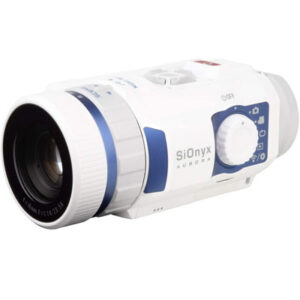
Sionyx Aurora Sport I Full Color Digital Night Vision Monocular
By introducing this monocular, Sionyx gave people a chance to observe the darkness around them in color. Its infrared sensors deliver colorful detailed views, giving users the impression like they were observing during the day.
All of these views can be recorded and watched remotely. This is done through the application that can be installed on a smartphone, which gives users a chance to observe the action live, relive the moments, download them, and share them. For increased capacity, an SD card of 32 GB is included.
Aurora Sport can resist water, too. Therefore, if people want to go fishing at night or boating, they can take it with them. With additional features like Wi-Fi, time-lapse, and easy navigation, it’s a versatile quality model. Another detail that strikes users as positive is the long range that works both in one and multiple colors.
Yet some users state certain downsides that have to do with the viewfinder being too small and the need for some adjustments in the zoom.
In general, though, it’s a nice model to try.
To know more: Cheapest night vison Goggles
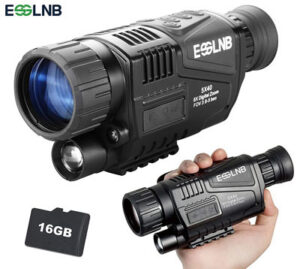
ESSLNB Night Vision Monocular 5X40 HD Night Vision Infrared Monocular
This monocular has proven to be suitable mostly for hunting and surveillance. This is due to its versatility, which enables it to be utilized both during the day and at night.
Among the top features is its CMOS special sensor whose role is to provide sharp views that are bright in dark conditions. Then, it has a digital zoom and an infrared illuminator that’s built-in. Thanks to these targets can be spotted in complete gloom even from 656 feet apart.
As for recording videos and taking photos, this hand-held model is like a small recorder people can carry around. The lithium battery that can be recharged is an asset, especially for the purpose of recording. To accompany it, there is the large storage on the 16G TF card.
Aside from this, users have some complaints related to the user’s manual being too simple and the not so user-friendly buttons, which tend to be harder to press.
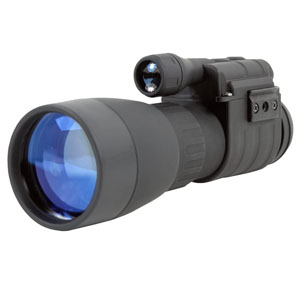
Sightmark Ghost Hunter Night Vision Monocular
Hunters find this one very useful as it can be attached to a weapon. Because it’s small in size and lightweight, hunters and shooters are able to hold it with their weapons without being too heavy to carry overall.
As soon as it detects the brightness, the monocular automatically shuts down, saving the battery. This is convenient for long trips with no frequent stops for charging or replacing the batteries. Moreover, the life of the battery without the infrared illuminator goes up to 72 hours as opposed to the 20 hours with the illuminator.
Leaving this aside, it incorporates focus rings that are touch-sensitive. On one hand, that way, users can adjust as much as they want but on the other hand, they require more time and skills to get accustomed to the rings. Also, another downside people report is that the quality of its materials isn’t as high as in some of the other models.
So, you should consider all of these details alongside some more precise specifications.

Solomark Night Vision Monocular
With this gadget, Solomark succeeded in making a monocular that both has a reasonable price and is efficient for viewing in the dark. Even without turning on features like the infrared illumination, it’s able to produce sharp images no matter how dim it is. However, the illuminator enables users to control the brightness at the desired level.
Aside from it, the monocular possesses a zoom of maximum two times. Therefore, the more people zoom in, the worse the views will be. Because of this, this model is suitable for observing at relatively close distances. Another reported con is that the viewing angle is small.
Still, it has some useful additions. Those that intend to use it for a longer time should have in mind that its battery can last for approximately 5 hours. For storing more images and videos, it comes with an SD card. Not to mention that it’s comfortable to hold with gloves on thanks to the grips made of rubber and its compactness.
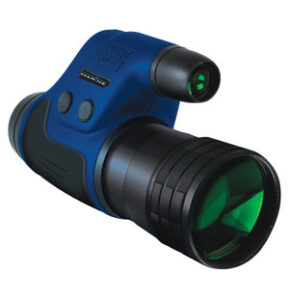
Night Owl Optics M4X-MR Night Vision Monocular
Considering all it has to give, this monocular is affordable. Although it falls under generation 1 and it has certain limitations, it servers people well when it comes to doing activities in dim light. While it’s obvious that it can’t really be utilized for dynamic and professional hunting and observation, it’s great for recreational purposes. That’s why both children and adults can hold it.
What makes it stand out from the crows is that it’s waterproof and dust-resistant. In fact, it can stay in water for half an hour in up to three feet depth and still come out undamaged. This comes in handy when people utilize it while camping in changing weather conditions or simply wanting to capture some views even though it’s raining.
Not to mention that it doesn’t weigh much. Due to the M4X, which shows that it has four powers, the magnification is fair and doesn’t impact the quality of the image too much. Related to this, the monocular has a manual focus requiring the users to adjust it by themselves.
As for reported downsides, this model apparently has issues with detection and range of recognition. Then, there is the pretty low resolution and the fact that there isn’t an attachment system.
Despite this, overall, it’s a useful model that deserves checking out. Here are some more specifications.

Vortex Optics Solo R/T Monocular
Unlike many other models, Vortex’s Optics Solo monocular includes R/T ranging reticle, which represents an angular measurement, which users can utilize to calculate the ranges. They can do this by putting the reticle in comparison with objects in the surroundings. The important thing here is to know the exact objects and their dimensions in order to get a correct range calculation.
Alongside this, this monocular has lenses that are multi-coated with coatings that have anti-reflecting capabilities. Thanks to this, they can collect light in dark conditions and produce brighter views. Also, the focus is simple to control since the focus wheel is big.
When it comes to durability, this model is made with a rubber strong armor that’s easy to grip at the same time. Also, it’s waterproof and fog proof, enabling you to take it with you no matter the weather. Related to this, it can be carried on a belt and a vest as it comes with a utility clip that can be easily attached to them.
However, you should note that there are some downsides associated with it. Firstly, it can’t be placed on a tripod. Beside this, users experienced troubles with the clarity of the views at longer distances.
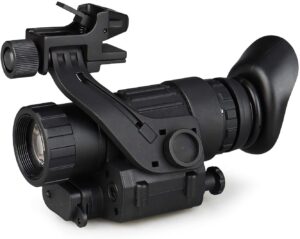
E.T Dragon PVS-14 Digital Night Vision Monocular
This is a premium model that comes in handy to all people that do activities completely in the dark. Even if it’s pitch black, it’s able to produce clear views of the targets. This is possible thanks to the tube for enhancing images, which belongs to the new generation.
It’s not alone, though. E.T Dragon also has a wide angle for seeing more of the surroundings and following targets that are moving. As a digital monocular, it offers the option to capture photos and videos in the dark with the infrared light on. And with its own playback function, it enables users to see what they have captured directly on the monocular’s screen. It should just be noted that the nighttime mode is black and white and the daytime one is in colors.
Connected to this, the viewing distance of this product tends to be 7.800 feet. At this range, hunters and observers can see objects, people, animals, and such clearly and brightly enough.
However, there are a few downsides that people experienced while utilizing this monocular. They’re related to the lack of autofocus and the locked magnification.
Those that are interested in this product can find more detailed specifications in these.
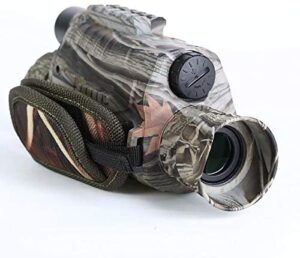
Sniper Night Vision Monocular
Apart from the nice looks, this model incorporates some useful features. Firstly, it has a Sony CMOS sensor for sharp views. To contribute to this, it contains an infrared illuminator, which additionally brightens the views in complete darkness.
Since it’s digital, users can record videos and take pictures with it and later view them on a TV and computer. The videos are with sound and can be played on the monocular’s LCD screen of 1.54 inches with the playback option.
What’s more, it can be utilized in changing weather conditions due to its water and fog resistance that comes with the fact that it’s totally sealed and filled with nitrogen. That way neither water nor dust can enter and damage it.
However, one of the main cons associated with this product is that apparently, the views can get blurry on long distances.
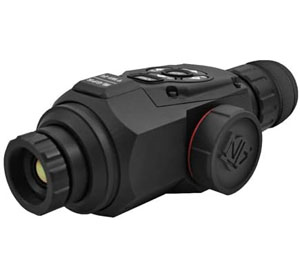
ATN OTS-HD 384 Thermal Smart HD Monoculars
Although this model is one of the most expensive ones on the list, it has some premium features that are worth checking out. The fact that it’s a smart and digital monocular explains a lot of them.
Moreover, the thermal sensor inside it is capable of detecting heat, allowing you to catch sharp views in complete darkness. To be precise in determining the distance, it has a smart rangefinder, as well. It’s built-in together with the e-zoom meant for a clear focus on distant targets.
What users find especially useful is the electronic compass. With it, they can navigate correctly in the darkness. As for reducing the negative effect of shaking hands on the image, the monocular has a 3D gyroscope that keeps the views steady.
Finally, the options for taking images and recording videos and sharing them with loved ones are a plus for those that want to go back and re-watch their journeys.
Yet, it’s worth mentioning that there are certain downsides to this model. For one, according to some users, it ate out a great deal of the battery fast.
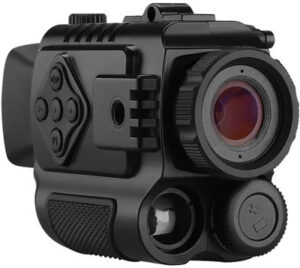
BOBLOV P4 Night Vision Monocular
Mainly, this black monocular can be used during hunting and observing wildlife. This is due to its digital zoom that gives users an opportunity to catch details from relatively far.
One of its most notable features, though, is the infrared lamp for adjusting the brightness. Depending on the ambient, it turns on automatically and adds more light to the views as well as the taken images and recorded videos. Even though it may not seem like it but it doesn’t waste the battery. Talking about the battery, it supports a rechargeable one. Also, there is a USB port for additional charging and connecting the monocular to a computer for extracting the data.
The compact design that’s lightweight makes this model portable and easy to bring with yourself on every trip. And the multi-functional hole allows the monocular to be mounted on a helmet and tripod for increased stability.
Still, users should be careful as a reported con for this model is that it doesn’t operate as efficiently in remote surroundings. Also, the batteries tend to be harder to come by.
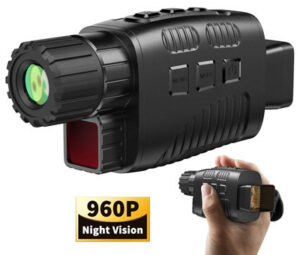
JStoon Night Vision Digital Monocular
Predominantly, this is considered to be a monocular for beginners. But it incorporates some options and features suitable for everyone. Starting from hiking, camping and hunting up to hunting and observing nature in the dark, they can be used in different situations.
The CMOS sensor, which is enhanced with infrared together with the small LCD screen enables a wholesome experience at night. Not only does it provide clear views, but it has an extensive viewing distance.
What many users find helpful is the interface. It’s made to be simpler with all options clearly visible and accessible. When it comes to power, five batteries are needed for the infrared vision. Just have in mind that they aren’t rechargeable, so people should carry spare batteries with them all the time.
Another thing you should know is that this is a small model that weighs a little and can be put in one’s pocket. For increased stability of the views, it can be mounted on a tripod.
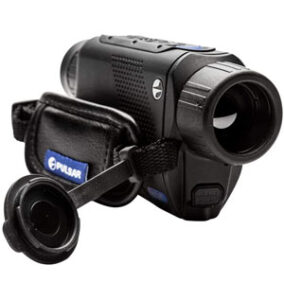
Pulsar Axion XM30 Night Vision Monocular
When comparing this monocular with the others in its class, it provides one of the highest magnifications. To enhance it even further, it incorporates a digital zoom. Related to viewing, there is a palette with eight colors for different situations, making the model more versatile.
Among the first things that can be noticed after getting this product is that it’s durable yet lightweight. This is possible thanks to the magnesium housing. Moreover, it’s designed to be compact and to fit in one’s hand and pocket nicely while delivering high performance. Not to mention that people can grip it and hold it easily without slipping.
Another useful feature is the video recorder that’s built-in. With it, taking photos and shooting videos comes easy. What’s also easy is sharing the captured content through the app on a smartphone or tablet. That way all files can be extracted and further viewed on computers and TVs.
Still, some users complain about a few things like the fact that the menu tends to disappear faster without giving the user an option to control when it fades manually. That way they lose their progress and have to start all over again once it’s back on.
Features and aspects to look out
Generations of Monoculars
When new people get introduced to the topic of monoculars, the first thing they hear is about all of these generations of monoculars as well as their own set of characteristics and utilization. And buyers should be aware of the generation of monocular they’ve bought or about to buy. That’s because this influences the features you’re getting, thus you’ll know when to use the product and what its limitations are. Also, the generation can sometimes be considered as a factor in the price you’re going to pay. So, in the following paragraphs, we’ll talk briefly about each generation of monoculars. For starters, there are just four of them.
Generation 1: The models belonging in this generation, as well as the digital ones, are some of the cheapest ones you’ll find on the market. More precisely, buyers tend to get them at prices below 250 dollars. Moreover, these monoculars are mainly aimed at hobbyists and individuals who are just getting into hunting or observing or are just casually using the monocular. Usually, people can use the monocular at nighttime but when the moon is a bit brighter as clarity isn’t one of the strongest aspects of this generation. It’s highly likely that people will have to use an infrared illuminator with these monoculars. Understandably, they don’t have the durability of the models in the other generations and, usually, don’t have weather-resistance.
Generation 2: One of the most significant changes (for the better) is seen in the transition from the first generation to this one. What’s more, these monoculars can be used by both professionals and amateurs. Even some members of law enforcement utilize them. When it comes to the specifications, the clarity is much better as is the range of detection. Still, these models have kept their affordability. Further, people can find a decent product of this generation at a price of a thousand dollars or something north of that. The design is pretty durable as common materials feature aluminum or long-lasting polymer. They can prove their worth in a hunting environment.
Generation 3: When compared with the ones before it, this generation has the most proficient and clear visuals. They present the user with a great overall performance and range of detection. With that being said, the models can be used in low-light conditions and even indoors. Generally, they’re waterproof and can resist pretty harsh weather conditions and drops or minor damages. These capabilities make them adequate for military usage. Also, the battery life is significantly longer than the one in other models. However, all of this comes at a price. In this case, the monoculars in this generation are quite expensive. To put that into numbers, usually, the minimal price is 2,500 dollars and the prices can even go higher than that.
Generation 4: Models, which belong in this generation, are very hard to come by as the generation-four technology isn’t fully mainstream yet. They’re reserved for highly professional surveillance tasks as well as tactical utilization. One of the dominant perks is the magnification power. The visuals are crisp and bright, too. So, it shouldn’t come as a surprise that these can be considered the priciest models at the moment. And when we say that, we mean a monocular that can cost around four thousand dollars and, in some cases, even more.
Mounting Capabilities
A majority of night vision monoculars come with certain mounting capabilities. That means that you can attach them to your helmet or even your weapon.
For hunters and those who practice airsoft and similar, the task frequently demands you to mount your monocular on a helmet system. That way, you can easily navigate and move freely. Plus, your hands are completely free to hold your weapon and they won’t be burdened with holding another device like a monocular.
Some experts claim that attaching the monocular to the weapon can be a bit more difficult in terms of efficient navigation. That’s because if the monocular is larger, it can obstruct the view and the user may end up tripping or falling. On the other hand, people still do this.
Furthermore, some night vision monoculars can be mounted on a tripod. This can be considered almost as a necessity when it comes to long hours of observations when the user doesn’t move much. If an individual wants to perform such a task, they should look for this feature in the specifications list of the monocular they’re looking to buy.
Infrared Illuminator
The IR illuminator comes in handy when the night is pitch black and there is no moon to even slightly shed some light on the path ahead. When the night vision capabilities aren’t quality in a monocular, an illuminator of this sort is a priority for the monocular to deliver clear visuals.
It’s worth noting that most monoculars have their built-in illuminator. But some don’t support the attachment of an external one. So, before one purchases a monocular, it’s a good idea to check if there’s a possibility to use an external IR illuminator while utilizing the model. If there isn’t such a possibility, manufacturers have found some alternatives that involve holding the illuminator in your hand. That may include illuminators the size of a small flashlight and similar.
Light Transmittance
As night vision monoculars are primarily used in low-light conditions, every light that the eye receives is vital. Light transmittance is measured in percentages and represents the amount of light that travels from the lens through the monocular and finishes in your eyes.
Not all models have the same clarity in the images they transmit. That may be a result of the lens coating or just the generation of monocular. So, to be sure, it’s recommended to look for models that have around ninety percent of light transmittance.
Field of View and Focus
Usually, the trade-off happens between magnification and field of view. Having said that, when the image is zoomed in, users have a narrower field of view and can’t see much around the subject they’re observing.
Opposite of that, when everything’s zoomed out, they have a chance to observe even the surroundings. To get the most out of the two, it’s best to look for models that have both a wide field of view and satisfactory magnification.
Further, the focus capabilities are linked to the before-mentioned ones. Monoculars that focus swiftly don’t deliver blurry images and users can see all the details thanks to the crispness of the visuals.
Frequently Asked Question (FAQs)
1) What are some of the bonus features I can look for when I’m looking to buy a night vision monocular?
Answer: It’s no secret that night vision monoculars can be used for a variety of activities. That’s why some models can come with some extra features. These features aren’t the most important ones, but can surely add a bit of value to the whole product. Make no mistake, for some buyers who want to get it all, these can make or break the purchase. Without further ado, recent models can special features that enable capturing images and recording videos. Some can even be connected to a personal computer or a television set due to a USB port and cable. Also, small SD cards for additional memory capacity can be compatible with a few monoculars.
2) What’s the eye relief distance I should look for?
Answer: For starters, eye relief is the space between the eyepiece of the monocular and the actual eye of the person. This feature becomes extremely relevant if the user wears glasses. That’s because if the space isn’t big enough, glasses wearers won’t be able to operate with the model. Some experts advise an eye relief of approximately fourteen millimeters as an adequate distance.
3) Should I look for a monocular based on the highest magnification power?
Answer: This isn’t a straight ‘yes’ or ‘no’ question. Of course, it’s great to have a great magnification because that way you’ll be able to stand at a great distance from the object you wish to observe and still see them closely. However, this isn’t always desirable, especially if you’re constantly moving. By that, we mean that if you move a lot, a great magnification will make it harder for you to navigate. Also, models that have it are slightly pricier and heavier. So, it all boils down to what you’re going to use the monocular for. If you’re static most of the time feel free to try to find high magnification.
4) Which night vision monocular is the most convenient when traveling?
Answer: Two of the most important aspects of a night vision monocular are lightness and compactness. Especially, when you’re abroad, you’ll need a monocular that is small enough and can easily fit in a bag for storing when you aren’t using it and even when you’re packing for transport. Additionally, if the monocular is small in size and light, it can easily be mounted on a helmet or a weapon.
Final Words
When you take all of this into consideration, it becomes clear that night vision monoculars are completely essential for viewing in the dark. No matter which activity you do, without them, it’s nearly impossible to spot objects and targets. However, since the market is full of various models that come at different prices, users struggle to decide which one to get for them. As you could see it all comes down to their preferences, budget, and things they want to sacrifice on account of others.
So, what is your choice? Do you plan to buy any of these monoculars? Or do you own some already? Share your opinions and experiences with us here.

